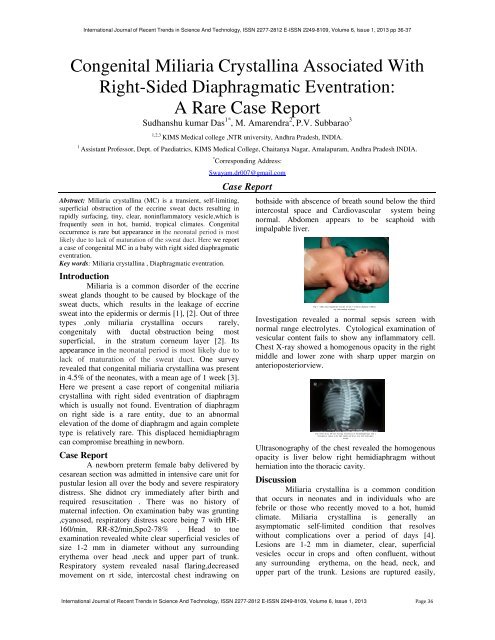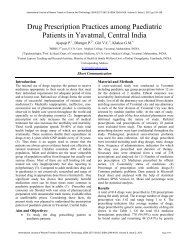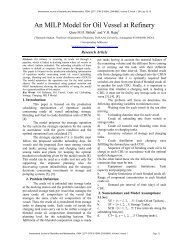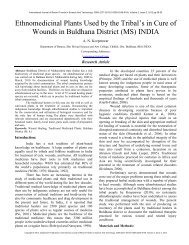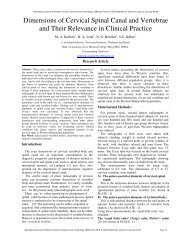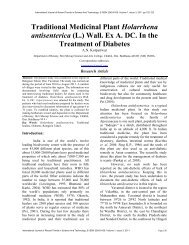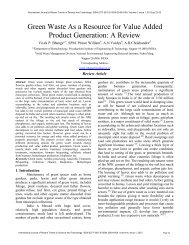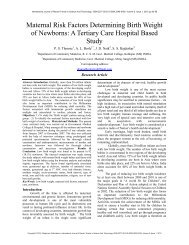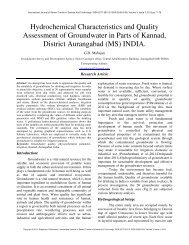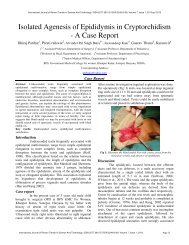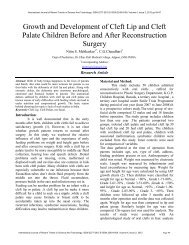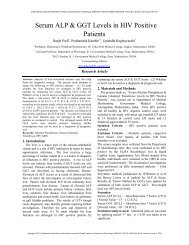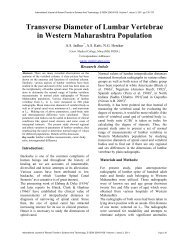Congenital Miliaria Crystallina Associated With Right ... - Statperson
Congenital Miliaria Crystallina Associated With Right ... - Statperson
Congenital Miliaria Crystallina Associated With Right ... - Statperson
Create successful ePaper yourself
Turn your PDF publications into a flip-book with our unique Google optimized e-Paper software.
International Journal of Recent Trends in Science And Technology, ISSN 2277-2812 E-ISSN 2249-8109, Volume 6, Issue 1, 2013 pp 36-37<strong>Congenital</strong> <strong>Miliaria</strong> <strong>Crystallina</strong> <strong>Associated</strong> <strong>With</strong><strong>Right</strong>-Sided Diaphragmatic Eventration:A Rare Case ReportSudhanshu kumar Das 1* , M. Amarendra 2 , P.V. Subbarao 31,2,3KIMS Medical college ,NTR university, Andhra Pradesh, INDIA.1Assistant Professor, Dept. of Paediatrics, KIMS Medical College, Chaitanya Nagar, Amalapuram, Andhra Pradesh INDIA.Abstract: <strong>Miliaria</strong> crystallina (MC) is a transient, self-limiting,superficial obstruction of the eccrine sweat ducts resulting inrapidly surfacing, tiny, clear, noninflammatory vesicle,which isfrequently seen in hot, humid, tropical climates. <strong>Congenital</strong>occurrence is rare but appearance in the neonatal period is mostlikely due to lack of maturation of the sweat duct. Here we reporta case of congenital MC in a baby with right sided diaphragmaticeventration.Key words: <strong>Miliaria</strong> crystallina , Diaphragmatic eventration.Introduction<strong>Miliaria</strong> is a common disorder of the eccrinesweat glands thought to be caused by blockage of thesweat ducts, which results in the leakage of eccrinesweat into the epidermis or dermis [1], [2]. Out of threetypes ,only miliaria crystallina occurs rarely,congenitaly with ductal obstruction being mostsuperficial, in the stratum corneum layer [2]. Itsappearance in the neonatal period is most likely due tolack of maturation of the sweat duct. One surveyrevealed that congenital miliaria crystallina was presentin 4.5% of the neonates, with a mean age of 1 week [3].Here we present a case report of congenital miliariacrystallina with right sided eventration of diaphragmwhich is usually not found. Eventration of diaphragmon right side is a rare entity, due to an abnormalelevation of the dome of diaphragm and again completetype is relatively rare. This displaced hemidiaphragmcan compromise breathing in newborn.Case ReportA newborn preterm female baby delivered bycesarean section was admitted in intensive care unit forpustular lesion all over the body and severe respiratorydistress. She didnot cry immediately after birth andrequired resuscitation . There was no history ofmaternal infection. On examination baby was grunting,cyanosed, respiratory distress score being 7 with HR-160/min, RR-82/min,Spo2-78% . Head to toeexamination revealed white clear superficial vesicles ofsize 1-2 mm in diameter without any surroundingerythema over head ,neck and upper part of trunk.Respiratory system revealed nasal flaring,decreasedmovement on rt side, intercostal chest indrawing on* Corresponding Address:Swayam.dr007@gmail.comCase Reportbothside with abscence of breath sound below the thirdintercostal space and Cardiovascular system beingnormal. Abdomen appears to be scaphoid withimpalpable liver.Fig-1. white clear superficial vesicles of size 1-2 mm in diameter withoutany surrounding erythemaInvestigation revealed a normal sepsis screen withnormal range electrolytes. Cytological examination ofvesicular content fails to show any inflammatory cell.Chest X-ray showed a homogenous opacity in the rightmiddle and lower zone with sharp upper margin onanterioposteriorview.Fig-2 Chest X-ray AP view showing Eventration of Rt hemidiaphragm with ahomogenous opacity in the right middle and lower zone with sharp uppermarginUltrasonography of the chest revealed the homogenousopacity is liver below right hemidiaphragm withoutherniation into the thoracic cavity.Discussion<strong>Miliaria</strong> crystallina is a common conditionthat occurs in neonates and in individuals who arefebrile or those who recently moved to a hot, humidclimate. <strong>Miliaria</strong> crystallina is generally anasymptomatic self-limited condition that resolveswithout complications over a period of days [4].Lesions are 1-2 mm in diameter, clear, superficialvesicles occur in crops and often confluent, withoutany surrounding erythema, on the head, neck, andupper part of the trunk. Lesions are ruptured easily,International Journal of Recent Trends in Science And Technology, ISSN 2277-2812 E-ISSN 2249-8109, Volume 6, Issue 1, 2013 Page 36
Sudhanshu kumar Das, M. Amarendra, P.V. Subbaraocontaining clear fluid material and resolved withsuperficial branny desquamation [5]. The cytologicexamination of the vesicular content fails to revealinflammatory cells or multinucleated giant cells (aswould be expected in herpes vesicles) .It should beconsidered in the differential diagnosis ofvesiculobullous eruptions in newborns. Eventration ofthe diaphragm is a condition in which all or part of thediaphragm is largely composed of fibrous tissue withonly a few or no interspersed muscle fibers. It is usuallycongenital but may be acquired [6]. congenitaleventration can be partial or complete [7]. In theformer, the defect is localized; whereas, in the latter, thediaphragm consists of a thin, membrane that is attachedperipherally to normal muscle. Complete eventration ofdiaphragm invariably occurs on the left side but partialeventration of the diaphragm occurs virtually on theright side [8]. In this case, the complete eventration ofdiaphragm was seen on the right side which is a rarity.<strong>Congenital</strong> eventrations can be isolated, although theysometimes are associated with other developmentaldefects such as cleft palate, congenital heart disease,situs inversus, or undescended testicle [9]. Thediagnosis of diaphragmatic eventration can usually bemade on standard PA and lateral chest films [10]. In thePA projection, the elevated diaphragm forms a roundunbroken line arching from the mediastinum to thecostal arch. Ultrasonography can help in establishingthe diagnosis of partial eventration and indistinguishing it from diaphragmatic nerve interruption.The diaphragm can be seen as a continuous thin layerabove the elevated abdominal viscera [11].Asymptomatic patients are managed conservatively butpatients with symptoms require surgery.Reference1. Champion RH. Disorders of sweat glands. In:Champion RH, Burton JL, Burns DA, Breathnach SM,eds.Textbook of Dermatology. 6 th ed. Malden, Mass:Blackwell Scientific Publications; 1998:1997-9.2. Wenzel FG, Horn TD. Nonneoplastic disorders of theeccrine glands. J Am Acad Dermatol. Jan1998;38(1):1-17; quiz 18-20.3. Hidano A, Purwoko R, Jitsukawa K. Statistical surveyof skin changes in Japanese neonates. PediatrDermatol. Feb 1986;3(2):140-4.4. Arpey CJ, Nagashima-Whalen LS, Chren MM, ZaimMT. <strong>Congenital</strong> miliaria crystallina: case report andliterature review. Pediatr Dermatol. Sep 1992;9(3):283-7.5. Haas N, Henz BM, Weigel H. <strong>Congenital</strong> miliariacrystallina. J Am Acad Dermatol. Nov 2002;47(5Suppl):S270-2.6. Laxdale OE, McDougall H, Mellin GW. <strong>Congenital</strong>eventration of the diaphragm. N EnglMed.1954;250:401.7. Reed, JA, Borden, DL. Eventration of the diaphragm.Arch Surg 1935; 31:30.8. Seaton A. Abnormalities and Diseases of theDiaphragm. In: Seaton A, Seaton D, Leitch AG,editors.Crofton and Douglas's RespiratoryDiseases. 5th ed. Blackwell Science, Oxford; 2000. pp.1234–49.9. Smith CD, Sade RM, Crawford FA, Othersen HB.Diaphragmatic paralysis and eventration in infants. JThorac Cardiovasc Surg 1986; 91:490.10. Deslauries J. Eventration of the diaphragm. Chest SurgClin North Am. 1998;8:315–30.11. Larson RK, Evans BH. Eventration of thediaphragm. Am Rev Respir Dis. 1963;87:753.Correspondence Details:Dr Sudhanshu kumar DasM.D , Asst Professor , Dept of PediatricsKIMS Medical college, Chaitanya NagarAmalapuram (A.P ) INDIA.Copyright © 2013, <strong>Statperson</strong> Publications, International Journal of Recent Trends in Science And Technology, ISSN 2277-2812 E-ISSN 2249-8109, Volume 6, Issue 1, 2013


